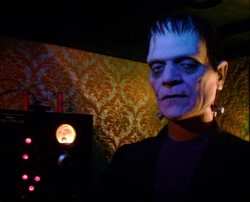
A wax model of Boris Karloff as Frankenstein's monster.
Frankenstein's monster (often incorrectly called Frankenstein) is a fictional character who first appeared in the 1818 novel Frankenstein; or The Modern Prometheus by the Englishwoman Mary Wollstonecraft Shelley. In Shelley's novel, Victor Frankenstein creates the monster from parts of several different dead bodies and uses his scientific knowledge to bring it to life. The monster does not have a name in the novel, and usually does not have one in adaptations either, being referred to simply as "the Monster" or "the Creature".
In the novel

Illustration from an 1831 edition of Frankenstein.
In the novel, Victor Frankenstein, a young man from Geneva who is studying biology and chemistry at Ingolstadt University in Germany, is fascinated by the mysteries of life. He successfully creates a new living being from the parts of several different corpses. However, he finds his creation repulsively ugly and runs away from the monster that he has made.
Following his work in creating the monster, Victor Frankenstein becomes seriously ill for four months. During that time, the monster sets off on his own into the world. Due to his ugliness, he is always met with rejection and fear. The monster goes into hiding near the home of a French family and learns to read and speak from their books. The monster hopes that the family's blind grandfather will accept him as a friend. When he is rejected by the French family too the monster finally turns angry and violent.
The monster makes his way to Victor Frankenstein's family home in Geneva and kills Victor's younger brother, William. The creator and the monster meet up again, the monster demanding that Victor Frankenstein create a female companion for him. He threatens that he will deny Victor his wedding night if Victor denies him his.
Victor Frankenstein starts to create a female companion for the monster but destroys it. The monster keeps his promise and kills Victor's wife, Elizabeth, on their wedding night. Victor pursues the monster northwards, seeking revenge, both monster and creator meet their demise in the Arctic Circle.
Adaptations

An advertisement for the first movie version of Frankenstein from 1910, showing Charles Ogle as the monster.
Several plays based on Mary Wollstonecraft Shelley's novel appeared within a few years of its publication. In the last hundred years comic books, animated cartoons, radio dramas, television series and specials and movies based on Frankenstein or featuring Frankenstein's monster have appeared.
The first screen adaptation of Frankenstein, a sixteen-minute silent film, was produced by Thomas Edison's film company in 1910, starring Charles Ogle as Frankenstein's monster. The film presents the monster, created from chemicals in a cauldron, as a product of Frankenstein's evil mind. When Frankenstein falls in love, the monster fades away and disappears.
In 1931 Universal released Frankenstein directed by James Whale and starring the British actor Boris Karloff as Frankenstein's monster. Although Dr. Henry Frankenstein (as he is called in the film) accidentally gives the monster a "criminal brain", stolen by his hunchbacked assistant, Fritz, the monster is initially childlike and innocent. However, Frankenstein's monster becomes violent and dangerous after Fritz mistreats him.
Universal released seven sequels to the 1931 movie: Bride of Frankenstein (1935), Son of Frankenstein (1939), The Ghost of Frankenstein (1942), Frankenstein Meets the Wolfman (1943), House of Frankenstein (1944), House of Dracula (1945) and the comedy Abbott and Costello Meet Frankenstein (1948). It is explicitly stated in Son of Frankenstein and Frankenstein Meets the Wolfman that the movies take place in Transylvania, a region which does not appear and is never mentioned in Mary Shelley's novel. The Universal films helped to popularize "Frankenstein" as the name of the monster. Most of them did not feature Frankenstein, the creator, but all of them featured the monster, always the same monster even though he was played by three other actors, Lon Chaney Jr., Bela Lugosi and Glenn Strange, in addition to Karloff.

Classic Comics #26 from October 1945 features an adaptation of Mary Shelley's Frankenstein.
In 1957 Britain's Hammer Film Productions produced The Curse of Frankenstein, directed by Terence Fisher, starring Peter Cushing as Baron Victor von Frankenstein (as he is called in the film) and Christopher Lee as Frankenstein's monster. For copyright reasons, Hammer were not allowed to recreate Boris Karloff's famous Frankenstein's monster make-up and had to refer to "the Creature" instead of "the Monster". The Creature in The Curse of Frankenstein has a damaged brain and tries to kill Baron Frankenstein as soon as it comes to life.
Five sequels to The Curse of Frankenstein followed: The Revenge of Frankenstein (1958), The Evil of Frankenstein (1963) Frankenstein Created Woman (1967), Frankenstein Must Be Destroyed (1969) and Frankenstein and the Monster from Hell (1974). The Hammer films centered on the character of Baron Victor von Frankenstein, who created a different monster in each film. A distribution deal with Universal meant that the monster in The Evil of Frankenstein was permitted to look like Karloff's version. Hammer also produced The Horror of Frankenstein an unsuccessful attempt to restart the franchise with younger actors, Ralph Bates as Baron Victor von Frankenstein and David Prowse as Frankenstein's monster, in 1970.
The last major movie adaptation of the novel was Mary Shelley's Frankenstein (1994) directed by Kenneth Branagh who also starred as Victor Frankenstein, Robert De Niro starred as Frankenstein's monster.
Frankenstein's monster, played by Aaron Eckhart, is the protagonist of the 2014 Australian-American fantasy action movie I, Frankenstein. In the film, the monster, who is given the name Adam, is unwittingly drawn into a secret war between demons and angelic beings which are known as gargoyles and ultimately saves all humanity.
Videos
External links
- Frankenstein, or The Modern Prometheus by Mary W. Shelley, the complete text of the novel on Wikisource.
- Free public domain audiobook of Frankenstein from LibriVox.
- "Frankenstein's monster (character)" at the Internet Movie Database.
- Frankenstein Wiki.
- Frankenstein's monster on Villains Wiki.
